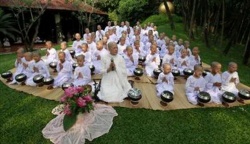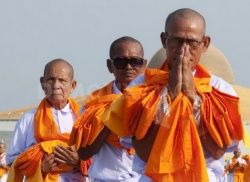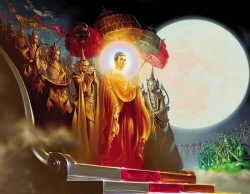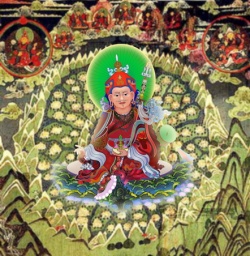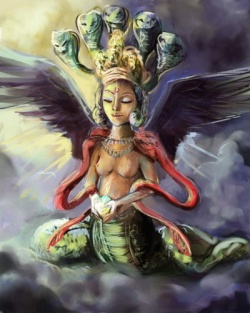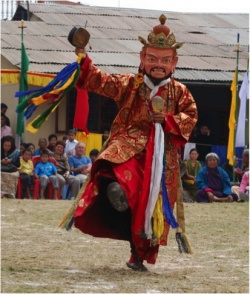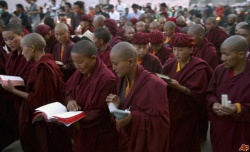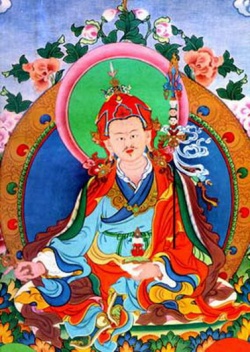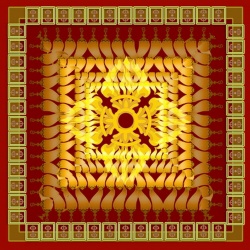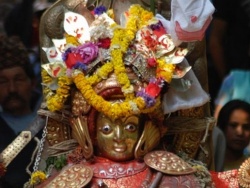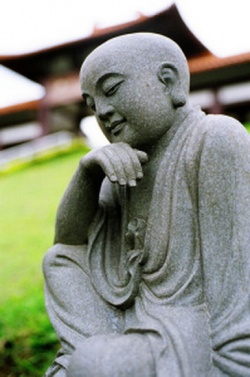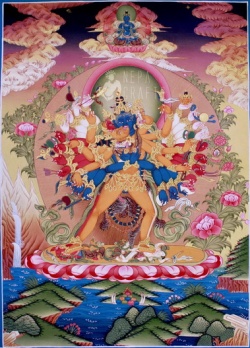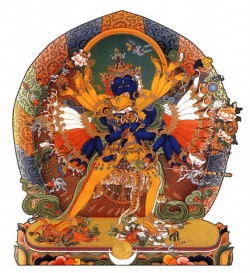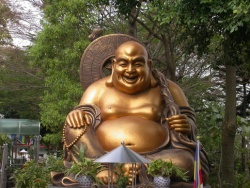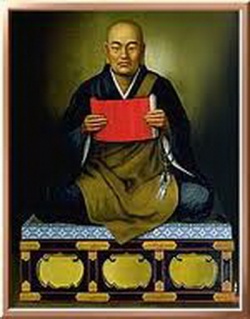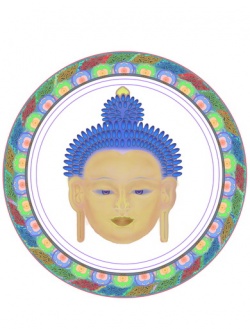The nameless religion: an overview of Bon shamanism
by Eileen Kernaghan
...there has always existed a vast and somewhat amorphous body of popular beliefs in Tibet, including beliefs in various techniques of divination, the cult of local deities (connected, above all, with certain mountains) and conceptions of the soul....although it is, to a large extent, sanctioned by and integrated into both religions (Buddhism and organized Bon) an appropriate term for it is the one coined by Rolf A. Stein, "the nameless religion". (Kvaerne 1987: 278)
For Tibetan Buddhists, the typical representative of the old Bon shamanist tradition is the pawo or nyen-jomo medium. From nineteenth century Himalayan traveller Alexandra David-Neel comes this eyewitness account of the pawo at work.
The pawo begins chanting, accompanying himself with a little drum or bell. He dances, first slowly, then faster and faster, and, finally, trembles convulsively. A being of another world, god, demon or spirit of a dead person, has taken possession of him. In a kind of frenzy he utters broken sentences, which are supposed to convey that which the invisible being wishes to communicate....(1931:36-37)
Madame David-Neel adds that what the departed soul usually communicates is a long list of sufferings and misfortunes in the next world. Often the spirit of the dead person cries out that he or she has been taken captive by a demon, and pleads to be set free. At this point another practitioner, the Bon sorcerer, steps in. He enters a trance, and his "double" sets out on a long, arduous journey to the dwelling place of the demon. The bystanders see the shaman struggling, panting and screaming, and know that he is wrestling with the demon in his attempts to free the captive spirit. (1931:37-38)
These intermediaries with the spirit world (who may be either male or female) are unconnected with the "White Bon" monasteries. They are inheritors of the earliest, unorganized Bon beliefs that prevailed in Tibet before the arrival of Buddhism. (Eliade 1964: 432)
The indigenous peoples of pre-Buddhist Tibet believed in divine heroes, many of them identified with sacred mountains (bTsan- po or Mighty Ones), a host of local "gods of the soil" or "gods of the place" who lived in rocks, and serpent-gods who lived in streams and springs. Whenever men built houses or tilled the soil, they risked offending these local spirits, who demanded propitiation for the use of their habitats. Otherwise, people would fall ill and die.
The priests who invoked and made offerings to these spirits were known as Bon (probably meaning Invoker) and gShen (Sacrificer). The religion itself was not called Bon, but simply "sacred conventions" or "the pattern of heaven and earth. "Later Tibetan writers as well as some western scholars have referred to this early religion as Bon, but the word never seems to appear with any other meaning but `priest' in really early Tibetan literature. Later on the term `Bon' came to be applied to the new religious developments, which incorporated some old beliefs and a very great deal of Buddhism...." (Snellgrove and Richardson 1968: 59)
Sacrificial killing played an important part in the indigenous culture of Tibet. The bodies of later pre-Buddhist kings, who were regarded as mortal rather than divine, were buried in elaborate tombs, while their souls were dispatched to the land of bliss with complex funeral rites that might go on for several years. As late as 800 A.D. chosen companions of the king were buried with him, so that they could go with him into the next world. Lesser mortals were accompanied by a sacrificed animal -- a yak, horse or sheep. (Kvaerne 1987:277) In Tibet, those Bon practitioners who conformed to Buddhist teachings by giving only "white" offerings became known as "White Bon". Those who continued to make animal sacrifices ("red offerings") were called Black Bon.
By the 14th Century the Bon-pos were fully organized as a special kind of Buddhism, though with certain differences. Unlike the Buddhists, whose teachings came from India, the Bons claimed that their faith originated in western Tibet (Shang-Shung or Zan-zun) and before that, from the land of sTag- gzigs (possibly pre-Muslim Persia) They honoured as their founder a legendary figure called gShen-rab.
In this article we are concerned not with the latter-day formalized Bon faith, but with the older animist-shamanist religion of Tibet -- the "nameless religion" -- whose practitioners, unbound by formal codes and doctrines, are in direct communication with the spirit world. According to Hoffman (1961) this same form of shamanism was once practised throughout inner Asia, including Siberia, Turkestan, Mongolia and China. In some isolated Himalayan valleys, it has survived in scarcely altered form to the present day.
Snellgrove and Richardson, in A Cultural History of Tibet, observe that pre-Buddhist religion in Tibet seemed to be entirely concerned with the affairs of this life. "Its purpose is to discover, usually by means of sortilege or astrological calculation, the causes of human ailments and misfortunes, and then to prescribe a suitable cure." The shaman, either through trance or divination, identifies the hostile god or demon that is causing the problem, then effects a cure by offering up a ransom. Sometimes the troublesome spirit was conjured into a device of crossed sticks and coloured threads (still used by Tibetans, and familiar to westerners as a "gods-eye") which trapped him like a bird in a cage. The demon was given his offerings, then thrown away. (1968:55)
Essential to these rites was a lengthy recitation, by the invoking (bon) priest, of ancient myths which described the origin, nature and function of various gods and demons, in order to invoke their aid.
Snellgrove and Richardson tell us that "Similar rituals with exactly similar recitations of ancient myths survive to this day this day among peoples of old Tibetan stock who penetrated the Himalayas in pre-Buddhist times and have since escaped the impact of later Tibetan Buddhist culture. Thus from a Nepalese people like the Gurungs we can probably even nowadays gain some impression of the working of such rituals in early Tibet." (1968: 57)
Anthropologist Stan Royal Mumford lived from 1981 to 1983 among the Gurung villagers of Gyasumdo, in the Nepal Himalayas. His research goal was to study the interaction of Tibetan Buddhist culture with co-existing non-Buddhist shamanism. In his introduction to Himalayan Dialogue he writes:
Present day Tibetan oracles (lha-pa) do not represent this older (pre-Buddhist) tradition, nor do the Bon-po, the non- Lamaist Tibetan sect that has been largely reformed. These are regarded as highly `Buddhist', since they also prohibit the `black' tradition of blood sacrifice that was defeated by the great lamas in Tibetan history. In Gyasumdo, however, the older pre-Buddhist shamanist tradition is still carried on by the Gurungs. (1989:6)
The Gurung nobility -- the Ghale clan -- claim to have come from Tibet centuries earlier. The Gurungs retain the pre- Buddhist Tibetan image of divine kingship, and believe that the ancestors of their nobility orginated in the upper world. (1989:8)
There are two types of shamanic practitioner: the Ghyabre, who performs funeral rites and delivers the soul to the land of the dead; and the Paju, who specializes in rites concerned with the earth and the underworld, including the expulsion of demons. Both Gurungs and the local Tibetans refer to the local Paju shaman, in Mumford's words "a virtuoso sacrificer", as `Black Bon'. The Ghyabre shaman, on the other hand, sees himself as becoming a "white Bon"-- even though he too performs animal sacrifices. (1989:32)) Keith Dowman, the translator of Lady Yeshe Tsogyel's autobiography, suggests that the shamans of Nepal and Mongolia were exiled from Tibet over this issue of animal sacrifice. (1984:114)
According to legends related to Mumford by Paju shamans, both Pajus and lamas in ancient times had extraordinary magical powers (among them corpse-raising and the ability to create landslides) which they made a habit of stealing from one another; and they competed in magical contests like the legendary competition between Milarepa and the Bon-po magician on Mount Kailas. The Gurung villagers assured Mumford that while the lamas have lost these powers, the shamans still possess them, though in diminished form. (1989:55-56)
The Gurung shamans and the Tibetans who have migrated into Gyasumdo share a belief in earth spirits, demons (bdud) and clan guardian deities (btsan). Like their Siberian counterparts, the Gurung shamans conduct a ritual hunt and sacrifice animals as an offering to the spirits; and they function as a channel of communication with the spirit world. (Mumford 1989:8)
Reinhard Greve of the University of Hamburg has made a study of the Thakali peoples of Northwest Nepal, whose language is closely related to that of the Gurungs. Officially Buddhists, the Thin-Syangtan-Chimtan- Thakali people are still dominated by the lamaist Ningmapa and Ngor-po sects, as well as by the reformed "White Bon". At the same time they keep alive the old shamanist-animist tradition, as practised by the dhom or aya-lama. At the time of Greve's study there were six surviving aya-lama practising in two Thakali villages. They trace their tradition back to Naro-bon- chung, the mythical hero of the Black Bon, who fought and lost a magical duel with the Buddhist saint Padmasambhava. (Greve 1984:157) The duty of the aya-lama is to worship and make offerings to the gods of the upper, middle and lower worlds; to provide protection against disaster; and to perform rituals for the fields. In his role as healer, he acts as intercessor between the sick person and the gods. (Direct healing rituals, on the other hand, are performed by itinerant Indo-Nepalese practitioners, the Jhakri.) (1984:160)
The approximately half million Tamangs living in the Himalayas in the region of the Kathmandu Valley form Nepal's largest ethnic group. They speak a Tibeto-Burmese language and, like the Gurung and Thakali, practise a form of pre-Buddhist Tibetan shamanism. The Tamangs have two distinct kinds of religious practitioner: lamas, who officiate at funerals and other ceremonies; and shamans (bombo) who are specialists in ritual healing. (Peters 1987:161)
Another Tibeto-Burmese tribe in Nepal, the Magar, has very similar shamanist traditions. "Among the Magar the elements of classical shamanism find their clearest expression in Nepal. With their main duties as shamans, they perform the ecstatic soul journey as well as the ritual birth of a new shaman on the top of the world tree." (Greve 1984:163)
Thus the rama shamans of the Magar, the Paju of the Gurung, the aya-lama of the Thakali, and the Tamang bombo belong to a common tradition of trans-Himalayan shamanism which has close parallels with classic North and Central Asiatic shamanism. (Greve 1984:160-161) As we will see, it is a tradition which has both strongly influenced, and in turn been influenced by, Tibetan Buddhist culture.
Just as Buddhism has replaced earlier animist beliefs in Tibet, the spread of Islam has overshadowed indigenous shamanist practises in the Indian Himalayas. M.H. Sidky observes that "Under Muslim hegemony ancient local deities have either been forgotten, or else reduced to the ranks of mountain spirits. Only in the most secluded valleys of Gilgit, Chitral and Hunza were the old gods still remembered and their altars adorned with sacrificial offerings of juniper boughs and goat's blood." (1994, 71-72).
Visitors to nineteenth and early twentieth century Gilgit and Hunza described their encounters with the bitan (or danyal in the Gilgit language) who practised a form of ecstatic religion closely related to the Bon shamanism of Tibet. The bitan drank goat's blood, breathed juniper smoke, and entered a trance state which enabled them to speak with mountain spirits called pari. (Sidky 1994:72)
The pari inhabit the high peaks and alpine meadows, regarded by the Hunza people as sacred places. Sidkey tells us, "Night and day, the Hunzakut affirm, one can hear [the voices of the pari] in the howling of the wind, the roar of mountain streams, the thundering echoes of falling rocks, and the creaking of the juniper trees. " (1994:73)
The pari are beautiful, but far from benevolent. Careless shepherds who allow their flocks to wander into the mountains or damage the alpine meadows are liable to be stricken with altitude sickness, or even swept away by avalanches. If offended, the pari may blight crops, injure livestock, steal children from the villages. Yet at the same time -- if they are correctly propitiated -- they will bestow good luck and prosperity. This propitiation is the responsibility of the bitan -- the shaman who communicates with the pari for the benefit of the whole community.
The Hunza shaman's mortal enemies are the shape-shifting spirits called shiatus or bilas, who lie in wait in graveyards and abandoned places, sometimes hiding inside boulders. Hordes of these demonic spirits may group together to attack the bitan, who must pray to his guardian spirits for protection. Or they may take the shape of a pari in order to trick an inexperienced bitan,, whom they then devour. (Sidky 1994:73 ff)
In these Himalayan mountain spirits -- the tall, golden-haired pari who often appear as birds, and the demonic shiatus -- there is an unmistakable echo of the fairy-like peries and hideous deevs of Persian myth, as well as the shape-shifting good and evil djinns of the Arab world.
In traditional Hunza society, the bitan, as oracles and channels of communication with the spirit world, were consulted during all important state events. And there were other aspects to their political role: "During their trances bitan would sometimes offer supernatural support for public grievances and alleviate the anxieties of the people. For example, in the name of the pari they might voice objections to state taxes, or challenge the improprieties of members of the upper class; these were issues that ordinary Hunzakut could not directly express for fear of being punished. In this manner, oracular sessions provided an institutionalized outlet for built- up social tensions." (Sidky 1994:79-80)
After the British invasion of Hunza in 1891, the reigning Mir took his mandate not from the pari, but from the British government in India. No longer playing an important role in state affairs, the bitan continued to serve their communities as soothsayers and healers. Around the turn of the last century, Islamic authorities forced the Mir to outlaw shamanism, though by 1934 soothsayers and healers were once again in evidence. Sidky says, "Since the completion of the Karakoram Highway in 1982 and the opening of the area to foreign tourists in 1986, a number of self-professed bitan have appeared who earn hefty fees by putting on bogus bitan shows for tourists. The Hunzakut themselves, often with a chuckle, refer to these mock soothsayers as `half- bitan' or `funny bitan'. In the eyes of Bitan Ibrahim [Sidky's informant] such people are charlatans worthy only of contempt." Today, Sidky adds, there are no more than three or four practitioners recognized by the Hunzakut as genuine bitan. (1994: 94)
THE BON COSMOS
For the indigenous peoples of Tibet the earliest kings were sons of the gods. The first king, Gna-k'ri-bstan-po, is said to have descended from heaven on a rope called dmu-t'ag. When a king died, he returned to heaven by means of this "sky-cord". He needed no tomb, because he left no earthly remains. One class of priests, the dMu -- Masters of the Rope -- were responsible for guiding the dead in their ascent to the dwelling place of the gods. (Eliade 1964:431)
The Bon and pre-Bon concept of a three-levelled universe with a rope or ladder connecting earth and heaven has persisted in Tibetan folk religion (Mumford 1989:31 citing Hoffman 1961:15) and is found in surviving shamanist cultures throughout the Himalayas.
In their imagination (the Gurung shamans) visit Khro- nasa, the Gurung underworld, going down nine ladders. The upper world is also reached by nine ladders, arriving at a mansion in Mu, the Gurung term for sky. The `middle' human world is connected to the upper world by a tree in the sacred grove at Tapje village, and also by a rock dome called Oble, the local Gurung land of the dead that is seen from the trail. (Mumford 1989:8)
Mumford notes that the Gurung description of this sacred tree is remarkably similar to the tree connecting the three worlds visited by Siberian shamans. (1089:8). (As Eliade points out, the Universal Tree that grows at the centre of the world and connects the cosmic zones of underworld, earth and heaven is common to all North and Central Asian mythologies.) (1964:37)
Mumford goes on to describe the ritual of the "red offering" -- a survival from shamanist Tibet which the Gurung shamans perform to this day.
A male cult of hunters catches a deer alive in the forest and brings it to the sacred grove. There, to the beat of drums and the clash of cymbals, the Ghyabre shaman sings his ritual chant, with the whole village looking on.
Open the golden lock of the north. Open the silver lock of the east. Open the iron lock of the south. Open the copper lock of the west. The doors must be opened. Open the golden door, the silver door, the iron door, the copper door. Open the doors, we are coming to make the offering.
At the foot of the sacred tree which unites the upper and lower worlds they tear out the deer's heart, offering it both to the underworld and the ancestral deity of the Ghale nobility. Mumford comments, "... a cosmic harmony is restored yearly by shamanic sacrifices, without which everyone would suffer affliction and poverty." (1989:45)
The Thakali share the Gurung concept of a three-levelled cosmos. The upper world is the home of friendly and benevolent gods; the middle world is inhabited by the sibda, the "lords of the soil" and by the spirits of the dead; and the lower world is the realm of the snake gods. Originally there were three types of aya-lama, reflecting the three cosmic regions; today all the functions of the aya-lama are carried out by the barti, representative of the middle world. (Greve 1984:159,161)
For the Tamang and Gilgit shamans, as for the Gurung and the indigenous bon shamans of Tibet, a rope or ladder serves as axis mundi to connect the human world with the realm of gods. In Gilgit the tradition of a golden chain connecting heaven with earth has survived into the 20th century. (Eliade 1964:431, citing Folklore XXV, 1914:397) For the Tamang, the means of ascent is a nine-runged ladder, with each rung representing a level of heaven. (Peters 1987:171)
However, as Larry G. Peters points out, the Tamangs have incorporated many of the concepts of Hindu and Buddhist Tantra into their shamanic belief system. Tamangs believe in three souls: the lower soul (the power of anger, used in sorcery) the heart soul (the soul of compassion and speech) and the soul of light, or consciousness, which the shaman learns to master, thereby gaining supernatural powers, including magical flight.
To a large extent, yoga has `somaticized' the symbolism and rites of shamanism. The axis mundi so typical of shamanism, the ladder reaching through the numerous levels of heaven, corresponds in Tantric yoga to the spinal column and the chakras that are likewise traversed in order to attain the final initiatory experience. The Tamang shaman's activation of the three souls...culminates in the ritual ascent to heaven...and parallels the ascent of the kundalini in Tantric yoga. (1987:172-173)
INITIATION AND TRAINING
"The process of becoming a Tamang shaman," Peters tells us, "is a long and arduous one. Training is both ecstatic and didactic." (1987:161) Shamanic powers seem to descend with the patrilineal line -- though not to any predetermined person. In contrast to many North American forms of shamanism, the Tamang shaman does not seek his vocation in a "vision quest". Rather it is visited upon him by spirits that "possess him and drive him into solitude, demanding that he become a shaman." In this state of "crazy possession" he shakes convulsively, shouts incoherently, weeps. His visions are chaotic, bewildering. He forgets to eat, becomes listless, or shakes with anxiety. Eventually he tears off his clothes and runs into the forest to live with the animals. He knows he is possessed. He does not understand why, or by what. (Peters 1987:163).
Now he must find a guru to guide him as he seeks to master these frightening new powers, which threaten to overwhelm him. He memorizes myths and mantras and learns ritual techniques. And like shamans everywhere he embarks on a long, arduous process of initiation, through which he achieves control over the trance state. He learns to enter and leave this altered state of consciousness at will; and at the same time, he masters the spirits by inviting them into his body and then exorcizing them.
Peters' Tamang informant Bhirendra was a part-time shaman and part-time farmer and labourer. At thirteen he was called to his vocation by an episode of madness that sent him to seek solitude in a forest and a cemetery, where evil spirits attacked him in a vision, nearly killing him. His experience mirrors that of many other North and Central Asian shamans: among the Tungus of Manchuria, for example, the initiate is visited by the spirit of a dead shaman, runs away to the mountains and feeds on animals that he catches with his teeth, then returns to his village dirty and bleeding, babbling incoherently, like a wild man. (Eliade 1964:16,18)
At this point Bhirendra realized his shamanic vocation, and undertook a seven-year apprenticeship in which he learned to control his mental state. His dead grandfather became his tutelary spirit, visiting him in dreams, and slapping his hands in his sleep if he forgot a mantra. Peters lists four stages in the Tamang initiation process, by means of which the shaman "gains successively more control over the possessed state, learns to utilize his power increasingly through ritual, and transforms crude visions into clear ones." The first state is the "calling", or "crazy possession". In the second stage, which is called "being ridden by the guru", the initiate is trained by his human teacher to call on his tutelary spirit at will. In the third stage the initiate gains greater control, and the tutelary spirit speaks coherently, instead of, as previously, in ramblings and mutterings. The initiate is now a shaman: he has achieved voluntary control of the spirits and is aid to be "riding the guru". (1987:168 ff)
The fourth and final initiation, called gufa, is a soul journey to heaven, to be described later in this article.
Unlike the Tamang initiate who has a human guru, the Hunza shaman is taught only by the spirits. The ability to become a bitan seems to be passed down through certain families. In the past there were both male and female bitan in Hunza, but of the handful who remain, Sidky tells us, all but one are male. (1994:74)
The child who is destined to become a bitan first experiences dreams and visions. Later he is visited by the pari, disguised as birds, butterflies, or tall human-like creatures, who reveal his special nature to him. Afterwards he becomes ill, suffers from headaches, loses his ability to speak and eat. If he refuses to accept his calling he may go insane, or die. However, once a man has become a bitan, he has the option of having his powers neutralized through a special ritual involving taboo substances-- the blood, flesh, and milk of a cow. (Sidky 1994:74)
The shepherd Bitan Ibrahim described to Sidky how he first came under pari influence and realized he was to become a shaman. When he was fifteen, the other shepherds saw that he was drawing more milk from his five goats than they were from their seventeen goats, and they decided that he must be favoured by the pari. The next day he set off in search of wild mountain flowers for the barley harvest festival. Though the season was still cold, he found entire fields of flowers. "Then I had my first encounter with the pari. They were human-like, but taller than any man I know, with fair skin, red cheeks, golden hair, and clad in green garments. Their mouths were wider than human mouths, their noses extended high into their foreheads, and their feet were backward. I was so frightened that I lost consciousness." (Sidky 1994:75)
The following day, at the barley festival, he behaved as though he were drunk or ill, and when the musicians played bitan music, he danced wildly. As a test, he was given goat's blood to drink -- since only bitan can drink goat's blood without vomiting. The final test was to dance in a village which had a reputation as a "bad place"-- "their women are harlots and their people are dishonest and unclean". Only a genuine bitan, Ibrahim explained, can dance and communicate with the pari in this foul place. (Sidky 1994:78)
Once a bitan is initiated, he acquires as his guardian spirits from one to fourteen pari, who help him to see into the future and tell of events happening in distant places. As well, they teach him to the shamanic arts of healing the sick, counteracting harmful magic and binding malignant spirits. (1994:78-79)
The Thakali shaman experiences no special vocation or calling: rather, the role of aya-lama is the hereditary right of the male members of one specific clan. During a period of training which takes from six to seven years, the apprentice must memorize epic poems recounting the deeds of his ancestors, invocations to the gods, magic spells which give him power over the gods and spirits, the various ritual techniques, and sundry methods of divination and diagnosis. He must learn the aya- lama's ritual language, a mixture of an old Thakali dialect, Tibetan, and possibly zan-zun -- although many apprentices memorize phrases without understanding their meaning. Finally the student aya-lama demonstrates his magical knowledge to his teacher in a nine-day-long examination, and is ordained in a public ceremony. (Greve 1984:158)
The training of the Gurung shaman involves a similar process of memorizing chants, spells, rituals and ancestral legends. The Gurung Paju claims superiority over the Gyasumdo lamas who must depend on written texts: "When knowledge is written down it loses its power because anyone can read it." Thus he explains why "the lamas have lost their ancient magical powers and the shamans have not." (Mumford 1989:53)
THE SHAMAN'S JOURNEY
Mumford describes in detail the "soul-calling" ritual used by the Gurung Paju shaman to heal the sick. First he takes the patient's pulse to determine whether the soul has been stolen by demons or by a living witch. Then he hangs a "golden ladder" made of yellow flowers from the ceiling of the house. His tutelary spirits, the Birds of the Four Directions, are symbolically sent on ahead. Dough effigies are placed beneath the ladder, to lure the shaman's ancestral spirit from his home in the land of gods above Tibet. The spirit enters first the effigy, then the shaman's body. Mumford tells us, "The Paju shakes during the jolting penetration. He is now empowered to undertake the journey back up the trail with his spirit retinue, which will lead up the mountain and the tree, then up the nine ladders to the upper world... to arrive at the palace of the gods. If the soul of the patient is not found there, he will have to search for it in the Gurung underworld, Khro-nasa." The Paju carries a trident in case of demon attack, and porcupine quills to light the air above like sparks of fire. When he reaches the land of the dead, he finds the way guarded by a barking dog. The dog's owners are humoured, the dog is tied to a hitching post, and the journey continues up the nine ladders to the sky-palace of the gods, where the shaman must court the errant soul into returning to earth with promises of golden earrings, garlands of flowers and beautiful clothes -- "a metaphoric luring of the bride." (1989: 170-173)
The Ghyabre shaman must undertake a similar journey when he performs the Gurung death rites. For the Gurungs, Mumford tells us, "the dead are nearby and recallable. Their presence in the land of the dead ... a day's walk up the trail is felt psychologically and socially." (1989:181) Once the corpse is disposed of, by burial or throwing into the river, the dead soul must be freed from the grasp of the demons who have caused his death. This is the responsibility of the Ghyabre shaman, who must travel to the underworld to deliver food to the wandering soul. The shaman returns with a pigeon which contains the soul of the deceased. The pigeon is placed in a cage. The shaman beats his drum, calls upon the Birds of the Four Directions, and chants an ancient legend of parents who descended into the underworld in search of their dead son. The shaman plucks a few of feathers from the bird and gives a bit to each member of the patrilineal clan, after which the bird is released to carry the soul back to the land of the dead. (1989:182-185)
Mumford comments, "There is good reason to regard the Ghyabre's death cult up to this point as having emerged from the same tradition as the Bon funeral once practised in Tibet." (1989:186) But from here on, he adds, the Gurung death rite is homologous to Siberian shamanism. Drum teams from other villages arrive, to dance, drum and sing funeral music, so that the soul can find its way back to the land of the dead. The shaman gives travelling instructions and admonishes the soul to depart quickly: "Don't stay here! Don't stay in the beer storage room. You no longer have the right to remain at the hearth...Only alive ones can stay here. You are dead now, go!" (1989:188) Then he guides the soul along the trail. Finally the soul comes to the place of Black Water-- one of the doors to the underworld. Once the soul has been persuaded to lie down and drink the Black Water, it realizes that it has died and there is no turning back. (1989: 1898) Still, when the shaman returns to the world of the living, he must be careful that the soul does not try to follow. While the soul's attention is distracted the shaman transforms himself into a vulture and flies back to the village.
Similarly, if the spirit of a dead person captures the soul of a living Thakali, the aya-lama must undertake a journey to the realm of the dead to search for the lost soul. The shaman is accompanied by his spirit helper, the che khyun (the mythical Garuda bird). The ritual journey does not take place in a state of ecstasy -- it is a spoken soul journey. Nonetheless, the aya-lama say that they are able to see the spirits of the dead -- though it is not clear whether they are able to communicate with them). Thus the journey could be interpreted as taking place in a trance state. Greve tells us that two of the six remaining aya-lama confirmed that in earlier times, the sarti-aya-lama were capable of ecstatic soul journeys. Until recently, when the Buddhist lamas took over the ceremony, the aya-lama were also responsible for guiding the soul to the world of the dead. (1984:160)
The Tamang shaman embarks on an ecstatic journey as the final stage of his initiation. It begins in a rice straw shelter perched high up on stilts, reached by climbing a nine-rung ladder. The initiate, wearing a white robe and peacock-feather headdress, plays the drum continually for seven days. During this time he is visited by ghosts and spirits. Tamang bombo say that they ascend and descend to heavens and underworlds where they encounter gods "face to face". Bhirendra told Peters that on the seventh day he had a vision in which he journeyed to the highest heaven and saw the supreme god of the shamans, Ghesar Gyalpo.
I walked into a beautiful garden with flowers of many different colours. There was also a pond and golden glimmery trees. Next to the pond was a very tall building which reached up into the sky. It had a golden staircase of nine steps leading to the top. I climbed the nine steps and saw Ghesar Gyalpo at the top. (1987:170-171)
Eliade maintains that Tibetan lamaism has "preserved the Bon shamanic tradition almost in its entirety" (1964:434), adding that "It would be chimerical to attempt in a few pages to list all the ...shamanic motifs present in Bon-po myths and rituals and persisting in Indo-Tibetan tantrism." (1964:432) He mentions, among other Tibetan Buddhist rituals, the prophetic trance of the State Oracle, and the Tibetan exorcist's search for, and calling back, of a patient's soul. He argues that the flying wheel of gShen rab in later Bon legend, and the wheel symbol in Tibetan Buddhism, have simply replaced the Bon shaman's flying drum. (1964:433) The Buddhist saint Padmasambhava flies through the air on his tiger, and he dances a mystic dance on the roof of his house clad in seven ornaments of bone -- strongly reminiscent, as Eliade points out, of the Siberian shaman's costume. (1964:434) As well, the secret language or spirit language of shamanism is reflected in the dakini or "cloud-spirit language" of Tantric Buddhism. (1964:440) Eliade also draws an analogy between the Tibetan Buddhist priest who recites the Bardo thodol, the Book of the Dead, to guide the soul along the roads of the afterlife, and the shaman who escorts the deceased into the beyond. (1964:438) In the Tibetan Buddhist Mystery Play as described by Evans-Wentz (1958), with its symbolic destruction of a clay figure (torma), we find a striking parallel with the exorcism rites of the Gurung shaman, who entices the demon into an dough effigy, then shoots it with arrows and throws it over a cliff, or traps it in the skull of a dog and buries it in the ground. (Mumford 1989: 143-144).
In Alexandra David Neel's With Mystics and Magicians in Tibet we find this description of the chod (cutting off) ritual practised by the Tibetan Buddhist naljorpa (an ascetic possessing magical powers): David-Neel calls it "The Dreadful Mystic Banquet".
The celebrant blows his bone trumpet, calling the hungry demons to the feast he intends to lay before them.... He visualizes a female deity -- the personification of his own will -- springing from his head, and standing before him, sword in hand, with one stroke she cuts off the head of the naljorpa. Then, while troops of ghouls crowd round for the feast, the goddess severs his limbs, skins him and rips open his belly. The bowels fall out, the blood flows like a river.... While the ghouls chew on his flesh, the naljorpa urges them on with words of ritual surrender. and cuts off his head with a single stroke." (1931:150)
Compare this with the Tamang shaman Bhirenda's vivid description of "evil spirits with long crooked fangs, others with no heads and eyes in the middle of their chests, still others carrying decaying corpses." He says "they attacked me, and before I knew it they were all over me devouring my body." (Peters 1987:164)
As Snellgrove and Alexander observe, "Not only were those who called themselves followers of Bon busy absorbing all they could of Buddhist doctrines and practices, but many of those who called themselves Buddhist were occupied in fitting the old Tibetan gods and indigenous rites into the framework of the new religion." (1968:108) "Under the veneer of Buddhist beliefs," Eliade tells us, "it is easy to recognize the old schema of the axis mundi, communications among the three cosmic zones, and the guardian who classifies souls."
Tibetan Buddhists and Gurung shamans are equally familiar with this legend summarized by Mumford in Himalayan Dialogue (1989:42)
Milarepa went with his disciples to Mount Tise. He met a Bonpo who challenged him to a contest of magical power to see which of them should control the mountain.... Early in the morning the Bonpo, riding his drum, flew up the side of the mountain... At that moment a ray of sunlight broke over the top of the mountain and beamed down into the window of (Milarepa's) hut.... Milarepa rode the sunbeam to the top of Mount Tise, arriving ahead of the Bonpo. Defeated, the Bonpo fell back, dropping his drum which rolled down the mountain slope and split in half. To this day, the drum of the Bonpo has only one side, while the drum of the lama still has two sides.
REFERENCES
Eliade, Mircea. Shamanism. Princeton, Bollingen Series, Princeton University Press, 1964.
David-Neel, Alexandra. With Mystics and Magicians in Tibet. London, The Bodley Head, 1931.
Initiates and Initiations in Tibet. New York, University Books, 1959.
Dowman, Keith. Sky Dancer: The Secret Life and Songs of the Lady Yeshe Tsogyel. London: Routledge and Kegan Paul, 1984.
Evans-Wentz, W.Y. Tibetan Yoga and Secret Doctrines. London, Oxford University Press, 1958.
Greve, Reinhard. "Processes of Change and Regression in Shamanist Practice". Proceedings of the International Conference on Shamanism, San Rafael, California, May 11-13, 1984.
Hoffman, Helmut. The Religions of Tibet. London, George Allen and Unwin, 1961.
Kvaerne, Per. "Bon". Encyclopedia of Religion, Mircea Eliade, General Editor. New York, Macmillan, 1987.
Ling, T.O. A Dictionary of Buddhism. New York, Charles Scribner's Sons, 1972.
Mumford, Stan Royal. Himalayan Dialogue: Tibetan Lamas and Gurung Shamans in Nepal. Madison WI, University of Wisconsin Press, 1989.
Peters, Larry G. "The Tamang Shamanism of Nepal" in Shamanism, compiled by Shirley Nicholson. Wheaton, Illinois, The Theosophical Publishing House, 1987.
Sidky, M.H. "Shamans and Mountain Spirits in Hunza". Asian Folk Studies 53: No.1, 1994.
Waddell, L. Austine. "Tibet". Encyclopaedia of Religion & Ethics, James Hastings, Editor. New York, Scribner's Sons, nd.
